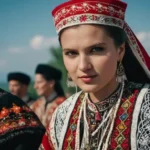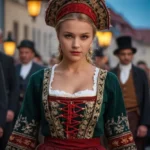Hungary, a land of rich cultural traditions and vibrant history, is renowned for its distinctive folk costumes that reflect regional identities and centuries-old craftsmanship.
Hungarian traditional clothing is more than just attire it’s an embodiment of the nation’s cultural pride and artistic excellence. Though modern fashion dominates daily life, these costumes remain integral to festivals, ceremonies, and cultural preservation.
A Historical Overview of Hungarian Traditional Clothing
Origins in Rural Communities
The roots of Hungarian folk costumes lie in the rural communities of the Middle Ages, where clothing served practical purposes while showcasing local artistry. Made from natural fabrics like linen and wool, these garments were tailored for comfort and durability, with regional variations reflecting Hungary’s diverse geography and traditions.
Influence of Nobility and Neighboring Cultures
During the Renaissance and Ottoman periods, Hungarian traditional clothing absorbed influences from nobility and neighboring cultures. Embellishments such as intricate embroidery, lace, and colorful patterns became prominent, merging practicality with elegance. These elements persist in contemporary interpretations of folk attire.
See also Exploring the Charm of Traditional Clothing in Romania
Exploring the Charm of Traditional Clothing in RomaniaKey Elements of Hungarian Folk Costumes
Women’s Clothing
- Blouses: Embroidered white blouses with puffed sleeves and lace details, often adorned with floral motifs unique to each region.
- Skirts and Petticoats: Layered skirts in vibrant colors or patterns, paired with starched petticoats for added volume.
- Aprons: Decorated with embroidery, aprons serve both functional and decorative roles, symbolizing tradition and craftsmanship.
- Headscarves and Headdresses: These range from simple kerchiefs to elaborate floral crowns, denoting age and marital status.
- Vests and Bodices: Tailored vests and bodices are embellished with intricate stitching or beadwork, emphasizing the silhouette.
Men’s Clothing
- Shirts: Loose-fitting linen shirts with embroidered collars and cuffs.
- Trousers: Woolen trousers or breeches, often paired with leather boots.
- Waistcoats and Jackets: Decorated with ornate embroidery, these garments reflect regional styles and social status.
- Hats: Felt or straw hats with decorative bands or feathers, adding a distinct touch to the ensemble.
- Belts: Wide leather belts, sometimes adorned with metalwork or embroidery, complete the attire.
Accessories
Hungarian traditional clothing includes meticulously crafted accessories such as:
- Jewelry: Beaded necklaces, brooches, and pins featuring folk motifs.
- Footwear: Leather boots, often hand-stitched, or decorative shoes for special occasions.
- Scarves and Shawls: Embroidered or patterned, these add warmth and elegance.
Regional Variations in Hungarian Folk Attire
Matyó Region
The Matyó region is celebrated for its vibrant embroidery, characterized by large, colorful floral patterns. Women wear richly adorned skirts and blouses, while men’s costumes include embroidered shirts and black trousers.
Kalocsa
Kalocsa folk attire is synonymous with delicate floral embroidery and vibrant hues. Women’s dresses are distinguished by intricate lacework and multicolored patterns, while men wear simpler, embroidered shirts.
Szeged
In Szeged, traditional clothing reflects pastoral influences, with woolen garments and practical designs. Women’s attire often features striped skirts and aprons, while men’s clothing includes embroidered vests and wide-brimmed hats.
See also Exploring the Charm of Traditional Clothing in the Czech Republic
Exploring the Charm of Traditional Clothing in the Czech RepublicTransylvania (Historical Region)
Transylvanian folk costumes, though outside modern Hungary, are closely linked to Hungarian heritage. These garments showcase detailed embroidery and vibrant patterns, with regional variations reflecting the area’s diverse influences.
Traditional Clothing in Hungarian Celebrations
Festivals and Parades
Hungarian festivals provide a vivid display of traditional attire:
- Busójárás (Mohács): A winter festival where participants wear folk costumes and masks to celebrate spring.
- Hungarian Folk Dance Festivals: Events where dancers don traditional clothing, accompanied by live folk music.
- Harvest Festivals: Celebrating agricultural heritage, these festivals feature colorful attire and community dances.
Weddings and Religious Ceremonies
Traditional Hungarian weddings often showcase elaborate folk costumes. Brides wear embroidered dresses and headdresses, while grooms don formal vests and embroidered shirts. Religious ceremonies also incorporate traditional attire, symbolizing cultural pride and spirituality.
Craftsmanship and Artistry in Hungarian Folk Costumes
Embroidery Traditions
Hungarian embroidery is renowned for its vibrant colors and intricate patterns. Techniques vary by region, with motifs inspired by nature, folklore, and local history. Matyó and Kalocsa embroidery are particularly celebrated for their artistic excellence.
Textile Techniques
Traditional garments are crafted using natural fabrics like linen, wool, and silk. Handwoven materials and natural dyes ensure durability and authenticity, while lace-making adds a touch of elegance.
Sustainable Practices
Hungarian artisans prioritize sustainability by using eco-friendly materials and traditional crafting methods. These practices not only preserve heritage but also promote environmental responsibility.
Preservation and Modern Revival
Cultural Organizations
Institutions like the Hungarian Heritage House and regional folk museums play a pivotal role in preserving traditional clothing. They organize workshops, exhibitions, and events to keep the legacy alive.
Contemporary Influence
Modern Hungarian designers often draw inspiration from folk costumes, integrating embroidery, patterns, and motifs into contemporary fashion. This fusion ensures that traditional elements remain relevant in modern attire.
Experiencing Hungarian Traditional Clothing Today
Museums and Exhibits
- Hungarian Open Air Museum (Szentendre): Features traditional costumes from various regions.
- Museum of Ethnography (Budapest): Showcases Hungary’s rich cultural heritage through folk clothing and artifacts.
Festivals and Markets
- Budapest Folk Fest: A celebration of Hungarian culture, featuring traditional costumes, music, and dance.
- Craft Markets: Ideal for purchasing handmade accessories and learning about regional attire.
Artisan Workshops
Across Hungary, workshops provide insights into the artistry behind traditional garments, offering hands-on experiences for visitors.
A Timeless Expression of Culture and Identity
Hungarian traditional clothing is a vivid representation of the nation’s history, artistry, and cultural pride. Whether worn during festivals, preserved in museums, or reimagined in modern fashion, these garments celebrate Hungary’s enduring heritage and regional diversity.
